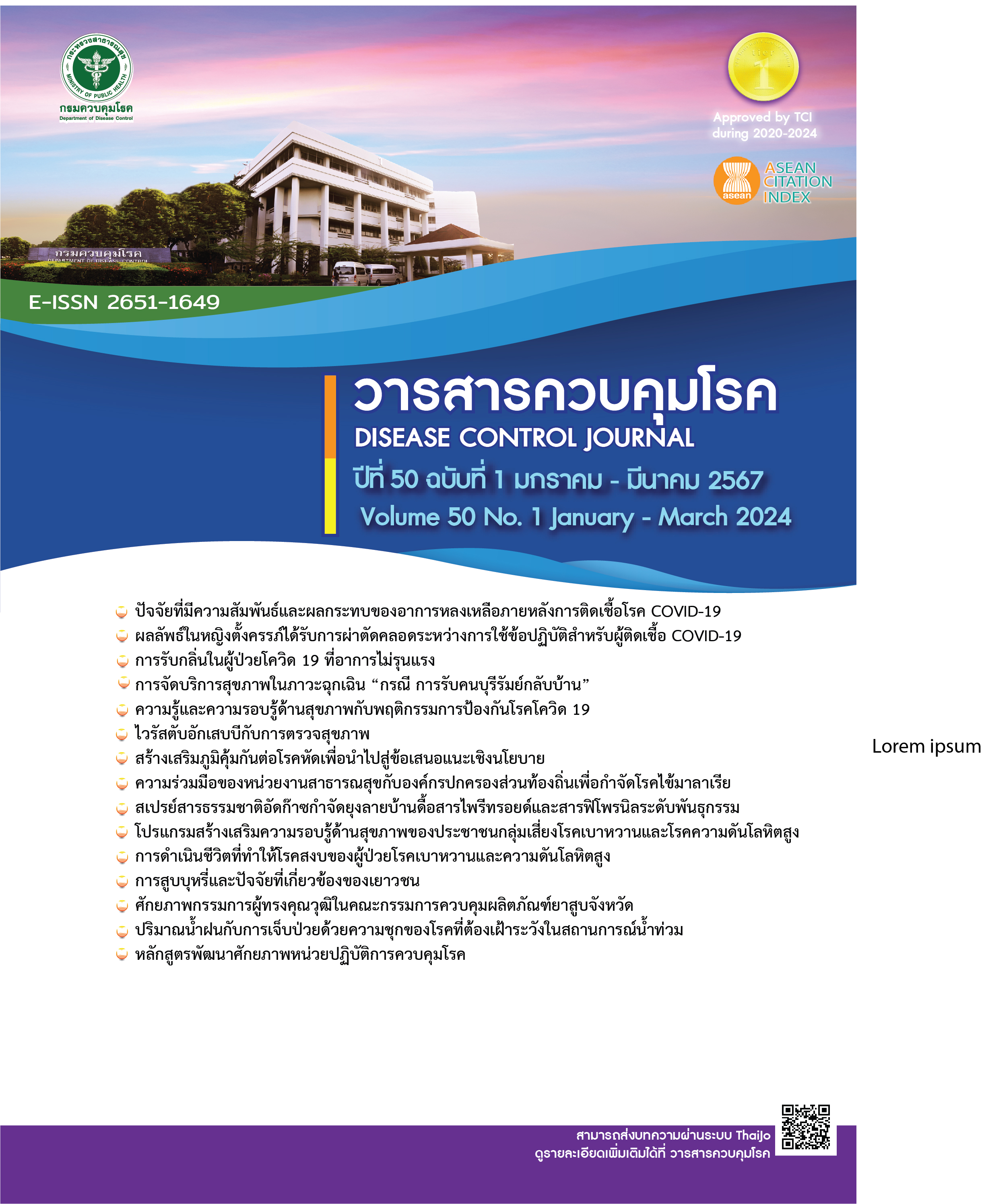Lessons learned and collaborative models between public health agencies and local administrative organizations at subdistrict level for malaria elimination
DOI:
https://doi.org/10.14456/dcj.2024.8Keywords:
collaboration, malaria elimination, Local Administrative OrganizationAbstract
Sustainable malaria elimination requires long-term political commitment and financial support. During 2018-2020, the Division of Vector-Borne Diseases under the Department of Disease Control (DDC)
intensely implemented capacity building and mobilized collaboration and support from local administrative organizations (LAOs) at subdistrict level for malaria elimination. The efforts resulted in a significant increase in funding support from 3,714,999 Baht in fiscal year 2017 to 7,530,513 Baht in fiscal year 2020. This qualitative study aimed to identify goals and processes employed by local public health agencies in working collaboratively with LAOs in five high performance provinces and to provide some lessons learned for other areas. Data were collected during January-April 2021 by interviewing 44 key informants, who were administrators and practitioners of public health organizations and LAOs in 11 subdistricts. Analysis was done through thematic analysis and subsequent comparison of commonalities and differences among provinces. The study found three models of engagements: 1) LAO supported budget for malaria related prevention and control activities; 2) Building knowledge and skills of malaria vector control for LAOs in cooperation with public health agencies; and 3) Building local ownership of malaria work through local collaboration with LAOs in subdistrict level, community leaders, village health volunteers, and other stakeholders. Key lessons learned were that setting specific goals for engagement with LAOs by Office of Disease Prevention and
Control and Provincial Health Office was a key factor leading to processes and outcomes. The results showed that building capacity and ownership for LAOs and communities in malaria work can result in sustaining malaria elimination and real public health decentralization.
Downloads
References
Department of Disease Control (TH), Bureau of Vector Borne Diseases. Guide to malaria elimination for Local Administrative Organizations and the health network. Nonthaburi: Department of Disease Control (TH); 2019. (in Thai)
Department of Disease Control (TH), Division of Vector Borne Disease. Online malaria information system [Internet]. [cited 2022 May 30]. Available from: http://malaria.ddc.moph.go.th/malariaR10/index_newversion.php (in Thai)
Department of Disease Control (TH), Communicable Disease Act B E 2558 (2515). Nonthaburi: Department of Disease Control (TH); 2016. (in Thai)
Office of Permanent Secretary, Ministry of Public Health (TH). Public health practice guidelines 2019 [Internet]. [cited 2023 Jun 16]. Available from: https://www.uckkpho.com/wp-content/uploads/2023/04/เเนวทางการปฏิบัติ_21279825.pdf (In Thai)
Announcement of the office of Prime Minister (TH). Public health reform plan 2018 [Internet]. [cited 2023 Jun 16]. Available from: http://nscr.nesdc.go.th/wp-content/uploads/2022/03/แผนการปฏิรูปประเทศด้านสาธารณสุข.pdf (in Thai)
Phenwan T, Saengow U, Ketwongkot T, Laohaprapanon A, Asksonthong R. Assessment of community health fund, Public Health Region 11, to support the next phase of policy making. Nakhon Si Thammarat: Department of Disease Control (TH); 2018. (in Thai)
Panacha S. Potential development of Local Health Security Fund Operations in Suphanburi province, Thailand. Region 4-5 Medical Journal. 2019; 38(1):1-11. (in Thai)
Ministry of Public Health. Announcement of Ministry of Public Health regarding Aedes mosquito breeding sites as cause of annoyance (TH) 2002 [Internet]. [cited 2023 Jun 16]. Available from: https://env.anamai.moph.go.th/web-upload/11xc410600758f76a9b83604e779b2d1de5/202303/m_page/38198/2244/file_download/7e6444bbd7d5efcdedbd7325b47c0f10.pdf (in Thai)
Ministry of Public Health. Letter from Ministry of Public Health to Ministry of Interior on the roles in control of dengue fever in the year 2013 (dated March 15, 2013) [Internet]. [cited 2023 Jun 1]. Available from: https://www.nakhonlocal.go.th/datacenter/doc_download/a_060613_165110.pdf (in Thai)
Ministry of Public Health. Memorandum of Understanding for collaboration on environmental management to prevent disease borne by Aedes mosquito between Department of Disease Control, Ministry of Public Health and Department of Local Administration, Ministry of Interior (dated June 11, 2019) [Internet]. [cited 2023 Jun 1]. Available from: http://www.dla.go.th/upload/document/type2/2019/6/21892_3_1560421586229.pdf (in Thai)
Downloads
Published
How to Cite
Issue
Section
License
Copyright (c) 2024 Disease Control Journal

This work is licensed under a Creative Commons Attribution-NonCommercial-NoDerivatives 4.0 International License.
Articles published in the Disease Control Journal are considered as academic work, research or analysis of the personal opinion of the authors, not the opinion of the Thailand Department of Disease Control or editorial team. The authors must be responsible for their articles.






